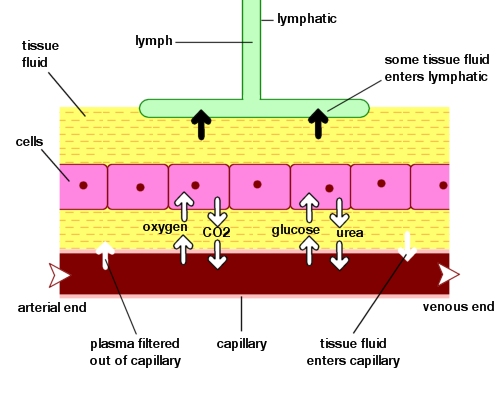Lymphatic System
This is a second transport system comprising a series of vessels, nodes and three organs viz. tonsils, thymus and spleen. The lymphatic system has 3 functions:
- Principally concerned with the transport & return of large molecules e.g. proteins which escape from the blood capillaries in the tissue fluids.
- Transports (large) lipids away from the intestine after digestion and into the blood system. These are too large to enter the small pores in the capillaries.
- Digests foreign material from the blood and produces lymphocytes and antibodies.
Lymphatic vessels are a network of blindly-ending thin-walled vessels called lymph capillaries which are found between the cells. These join up to form larger vessels, lymphatics, which eventually unite into two main ducts, right lymphatic duct & thoracic duct. These empty their contents into the large veins entering the right atrium.
Lymph transport is uni-directional and very slow and is brought about by:
- Pressure of lymph that accumulates in the tissues.
- Muscular movement in conjunction with numerous one way valves.
- Current evidence suggests that some larger lymph vessels contain autonomous pumps.
Lymph nodes are swellings covered by a capsule of connective tissue and found at various locations along the lymphatics. They are scattered throughout the body, usually in groups. Typically, these groups are arranged in two sets - superficial & deep. Lymph nodes are lined by macrophages which remove bacteria, foreign bodies & cell debris from the lymph as it passes through. During infection, they are the site of lymphocyte production and various plasma cells which produce antibodies.
The major groups of superficial lymph nodes are:
iguinals | groin |
poplitteal | behind the knee |
supatrochlea | behind the elbow |
axillary | armpit |
supraclavicular | above the clavicle |
submandibular | beneath the mandibles (jawbone) |
cervical | neck |
occipital | base of the skull |
thoracic duct | line of the sternum |
right lymphatic duct | anterior auricular | front of ears |
posterior auricular | behind ears |
There are other important deep lymph nodes, e.g. intestinal, iliac.

